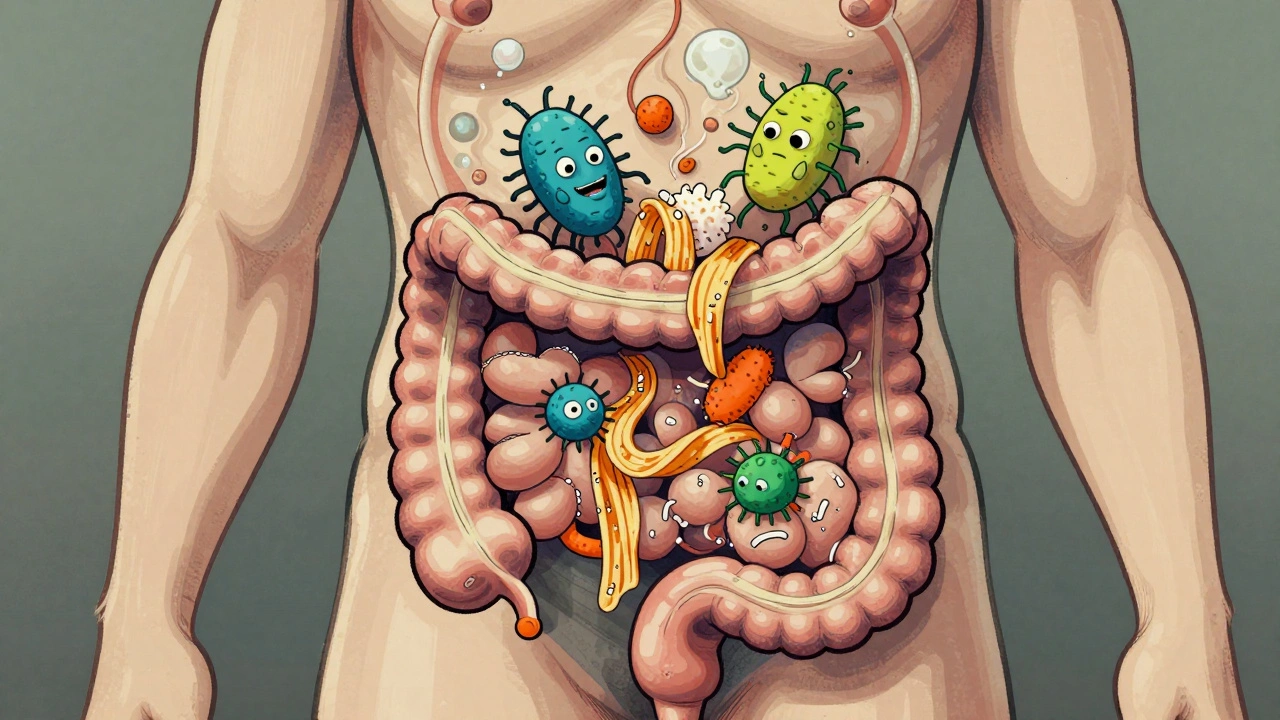Trichomoniasis Long-Term Risk Calculator
This calculator estimates your risk of developing long-term health complications from untreated trichomoniasis based on the duration of infection and other factors. Remember, trichomoniasis is easily treatable with metronidazole, which can prevent these complications.
Your Risk Assessment
When a Trichomoniasis infection caused by the protozoan Trichomonas vaginalis goes untreated, the damage can linger for years. Many people think a single episode is harmless, but the reality is that the parasite can set off a cascade of health problems that show up long after the initial symptoms disappear.
long-term health effects of untreated trichomoniasis include chronic pelvic pain, higher risk of infertility, and even complications during pregnancy. Below you’ll find a complete rundown of what can happen if the infection is left to run its course.
Key Takeaways
- Untreated trichomoniasis can lead to pelvic inflammatory disease (PID) in up to 30% of women.
- Both men and women face a higher chance of acquiring or transmitting HIV.
- Persistent infection is linked to infertility, preterm birth, and increased cervical cancer risk.
- Early diagnosis and a short course of metronidazole can stop the chain reaction.
- Regular STI screening is the most effective prevention strategy.
What Is Trichomoniasis?
Trichomoniasis is a sexually transmitted infection that affects the urogenital tract and is caused by the flagellated protozoan Trichomonas vaginalis. It is the most common non‑viral STI worldwide, with an estimated 156million new cases each year.
How the Infection Persists Without Treatment
The parasite adheres to the epithelial cells of the vagina, urethra, and prostate, forming a protective biofilm that shields it from the immune system. Because the body’s defenses can’t fully clear the organism, the infection becomes chronic, flaring up intermittently and often going unnoticed.

Major Long‑Term Health Risks
Research from the Centers for Disease Control and Prevention (CDC) and several longitudinal studies show that untreated trichomoniasis is far from benign. Below are the most serious complications:
Pelvic Inflammatory Disease (PID)
When the infection spreads upward, it can inflame the uterus, fallopian tubes, and ovaries-a condition known as Pelvic Inflammatory Disease. PID can cause chronic pelvic pain, ectopic pregnancy, and infertility. A 2023 cohort study found a 2.5‑fold increase in PID rates among women with untreated trichomoniasis compared to those who received prompt therapy.
Infertility
Both women and men can experience reduced fertility. In women, scarring of the fallopian tubes from PID blocks sperm passage. In men, the parasite can irritate the urethra and decrease sperm motility. One meta‑analysis reported a 19% higher odds of infertility in couples where the woman had a history of untreated trichomoniasis.
Increased HIV Transmission
Inflammation caused by the parasite creates tiny lesions that act as entry points for HIV. Studies in sub‑Saharan Africa show that women with trichomoniasis are up to three times more likely to acquire HIV during unprotected sex, and infected men are more likely to pass the virus to partners.
Pregnancy Complications
For pregnant people, untreated infection raises the risk of preterm birth, low birth weight, and neonatal intensive care admission. A 2022 prospective study of 3,200 pregnant women found a 1.8‑fold increase in preterm delivery among those who tested positive for trichomoniasis but did not receive treatment.
Cervical Cancer Risk
Chronic inflammation may promote oncogenic changes in cervical cells. While the link is not as strong as with HPV, a 2021 case‑control study identified a modest but statistically significant association between persistent trichomoniasis and high‑grade cervical lesions.
Chronic Urogenital Discomfort
Even after the acute symptoms fade, many people report ongoing itching, burning, and a gritty feeling during intercourse. This chronic discomfort can affect quality of life and mental health.
Who Is Most at Risk?
The infection does not discriminate, but certain groups see higher prevalence:
- Sexually active women under 30.
- Individuals with multiple recent partners.
- People who use intrauterine devices (IUDs) without regular STI screening.
- Those living in low‑resource settings where access to diagnostics is limited.
Diagnosis and Why Prompt Treatment Matters
A simple vaginal swab or urine test can detect Trichomonas vaginalis. The first‑line therapy is a single dose of Metronidazole an antibiotic that kills the parasite within hours. When taken correctly, cure rates exceed 95% and the cascade of long‑term complications is halted.
What Happens When It Remains Untreated?
If the infection is ignored, you may notice the following pattern over months or years:
- Intermittent vaginal discharge or mild irritation.
- Increasing pelvic discomfort and occasional lower‑back pain.
- In women, missed menstrual periods or abnormal bleeding due to PID.
- Difficulty conceiving after a year of trying.
- For pregnant individuals, early labor signs such as regular contractions before 37 weeks.

Comparison: Untreated vs. Treated Infection
| Health Outcome | Untreated | Treated (Metronidazole) |
|---|---|---|
| Pelvic Inflammatory Disease | 30% incidence | 3% (mostly due to reinfection) |
| Infertility (both sexes) | 19% higher odds | Baseline population risk |
| HIV acquisition/transmission | 2‑3× increased risk | No added risk |
| Preterm birth | 1.8× higher risk | Risk comparable to uninfected peers |
| Cervical lesions | Modest increase | Risk eliminated |
Quick Checklist for Anyone Who Suspects an Untreated Infection
- Schedule a simple STI test-even if symptoms are mild.
- If positive, complete the full metronidazole regimen (single dose or 7‑day course).
- Retest 3 weeks later to confirm cure.
- Inform all recent sexual partners so they can get tested.
- Use condoms consistently to prevent reinfection.
Prevention Tips
Reducing the chance of getting trichomoniasis in the first place is easier than dealing with its fallout. Follow these habits:
- Use male or female condoms every time you have sex.
- Get screened for STIs at least once a year if you have multiple partners.
- Limit the number of concurrent sexual partners.
- Consider HPV vaccination; while it doesn’t protect against trichomoniasis, it reduces overall cervical cancer risk.
Frequently Asked Questions
Can men suffer long‑term complications from untreated trichomoniasis?
Yes. Men can develop chronic urethritis, epididymitis, and reduced sperm quality. While PID is a female‑specific condition, the inflammation in men still raises the risk of HIV transmission and can affect fertility.
Is a single dose of metronidazole enough?
For most uncomplicated cases, a single 2‑gram dose cures over 95% of infections. In cases of recurrent infection or pregnancy, a 7‑day course (500mg twice daily) is recommended.
How long does it take for fertility to return after treatment?
If PID has not caused permanent scarring, fertility often normalizes within 3-6 months after successful treatment. Persistent tubal damage may require assisted reproductive techniques.
Can I get re‑infected after being cured?
Re‑infection is possible, especially if partners are not treated simultaneously. Practicing consistent condom use and retesting partners lowers this risk dramatically.
Does trichomoniasis increase the chance of cervical cancer?
Chronic inflammation from the parasite can facilitate the development of high‑grade cervical lesions, especially when co‑infected with HPV. While it’s not a primary cause, untreated trichomoniasis adds a measurable risk.







Adam Martin
October 12, 2025 AT 20:23Well, here we are, another deep dive into the world of tiny parasites that apparently love to throw a wrench into our reproductive plans. I get the vibe that the original author wanted to scare us into a pharmacy run, but let’s be real- most of us read this, nod, and bookmark the “take a pill” part for later. Sure, untreated Trichomonas can lead to PID, infertility, or even a higher HIV risk, but the magnitude varies wildly based on personal health, access to care, and, frankly, how often you’re willing to get tested. If you’re in a steady monogamous relationship and get screened yearly, the odds of hitting those dreaded outcomes are far lower than the article makes it sound. Also, kudos for the risk calculator, but remember that models are only as good as the assumptions you feed them, and most of those numbers come from epidemiological studies with inherent biases. Bottom line: don’t panic, get tested, and if you’re positive, finish the metronidazole course- simple as that.
Ryan Torres
October 22, 2025 AT 12:23Oh sure, just swallow a pill and all the conspiracies melt away 😒. What they don’t tell you is that Big Pharma keeps the metronidazole price inflated so they can keep us coming back for "follow‑up" appointments. Meanwhile, those tiny protozoa are probably engineered to be resistant to the next generation of antibiotics, and the CDC’s “research” is funded by the same corporations that profit from the outbreak. If you’re not comfortable with the mainstream narrative, doubt everything they throw at you-including the "low risk" stats in that calculator. 🧐💊
shashi Shekhar
November 1, 2025 AT 04:23Alright, let’s cut the drama. You’ve got a bunch of studies that say untreated trich is a problem, but most of the data comes from high‑risk populations where other STIs are already messing things up. If you’re a low‑risk, monogamous person, the odds of going from a mild itch to infertility are practically zero. The article loves to list scary percentages, but it forgets to mention the baseline risk of PID from any cause. So before you get all worked up, maybe double‑check how many of those numbers are actually applicable to you.
Marcia Bailey
November 10, 2025 AT 20:23Hey there! Just wanted to add a quick note: if you do test positive, completing the full metronidazole regimen is key. It’s not just about feeling better right now; it knocks out the parasite completely and prevents the cascade of complications mentioned. Also, consider retesting after 3 weeks to confirm cure-sometimes a tiny residual infection can linger. And remember, getting your partners tested and treated at the same time cuts down the reinfection risk dramatically. Stay healthy! 😊
Hannah Tran
November 20, 2025 AT 12:23To expand on the clinical picture, Trichomonas vaginalis induces a pro‑inflammatory cytokine milieu, notably elevating IL‑1β, IL‑6, and TNF‑α levels within the genital tract. This microenvironment not only compromises epithelial barrier integrity but also augments the recruitment of CD4+ T‑cells, thereby creating a fertile ground for HIV entry. Moreover, chronic exposure to the parasite’s lipophosphoglycan can dysregulate the local microbiota, fostering dysbiosis that further predisposes to opportunistic infections. In men, the organism’s adherence to urethral epithelium can provoke chronic urethritis, leading to sperm motility deficits via oxidative stress pathways. The cumulative effect is a subtle yet clinically significant impact on reproductive health, which underscores the importance of early detection and eradication. If you’re navigating fertility concerns, a thorough STI work‑up, inclusive of trich testing, should be part of the evaluation.
Crystle Imrie
November 30, 2025 AT 04:23Drama alert: a single dose of medicine beats a lifetime of regret. #HealthCheck
Shelby Rock
December 9, 2025 AT 20:23i think we all forget that the tiniest critters can teach us big lessons about balance – sometimes we get too caught up in numbers and miss the simple truth: check, treat, move on. life’s short, dont let a microbe write your story.